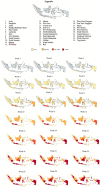A spatial-temporal description of the SARS-CoV-2 infections in Indonesia during the first six months of outbreak
- PMID: 33351801
- PMCID: PMC7755207
- DOI: 10.1371/journal.pone.0243703
A spatial-temporal description of the SARS-CoV-2 infections in Indonesia during the first six months of outbreak
Abstract
Background: Since the first cases reported in Wuhan, China, in December 2019, the Severe Acute Respiratory Syndrome Coronavirus 2 (SARS-CoV-2) has spread worldwide. In Indonesia, the first case was reported in early March 2020, and the numbers of confirmed infections have been increasing until now. Efforts to contain the virus globally and in Indonesia are ongoing. This is the very first manuscript using a spatial-temporal model to describe the SARS-CoV-2 transmission in Indonesia, as well as providing a patient profile for all confirmed COVID-19 cases.
Method: Data was collected from the official website of the Indonesia National Task Force for the Acceleration of COVID-19, from the period of 02 March 2020-02 August 2020. The data from RT-PCR confirmed, SARS-CoV-2 positive patients was categorized according to demographics, symptoms and comorbidities based on case categorization (confirmed, recovered, dead). The data collected provides granular and thorough information on time and geographical location for all 34 Provinces across Indonesia.
Results: A cumulative total of 111,450 confirmed cases of were reported in Indonesia during the study period. Of those confirmed cases 67.79% (75,551/111,450) were shown as recovered and 4.83% (5,382/111,450) of them as died. Patients were mostly male (50.52%; 56,300/111,450) and adults aged 31 to 45 years old (29.73%; 33,132/111,450). Overall patient presentation symptoms of cough and fever, as well as chronic disease comorbidities were in line with previously published data from elsewhere in South-East Asia. The data reported here, shows that from the detection of the first confirmed case and within a short time period of 40 days, all the provinces of Indonesia were affected by COVID-19.
Conclusions: This study is the first to provide detailed characteristics of the confirmed SARS-CoV-2 patients in Indonesia, including their demographic profile and COVID-19 presentation history. It used a spatial-temporal analysis to present the epidemic spread from the very beginning of the outbreak throughout all provinces in the country. The increase of new confirmed cases has been consistent during this time period for all provinces, with some demonstrating a sharp increase, in part due to the surge in national diagnostic capacity. This information delivers a ready resource that can be used for prediction modelling, and is utilized continuously by the current Indonesian Task Force in order to advise on potential implementation or removal of public distancing measures, and on potential availability of healthcare capacity in their efforts to ultimately manage the outbreak.
Conflict of interest statement
The authors have declared that no competing interests exist.
Figures




References
-
- World Health Organization, Coronavirus Disease 2019 (COVID-19) Weekly Epidemiological Update (WHO, 2020); Geneva, August 23, 2020. Available from: https://www.who.int/docs/default-source/coronaviruse/situation-reports/2... [Accessed August 23, 2020]
-
- A Wilder-Smith MD, D O Freedman MD, Isolation, quarantine, social distancing and community containment: pivotal role for old-style public health measures in the novel coronavirus (2019-nCoV) outbreak, Journal of Travel Medicine, Volume 27, Issue 2, March 2020, taaa020, 10.1093/jtm/taaa020 - DOI - PMC - PubMed
MeSH terms
Substances
Grants and funding
LinkOut - more resources
Full Text Sources
Medical
Miscellaneous

